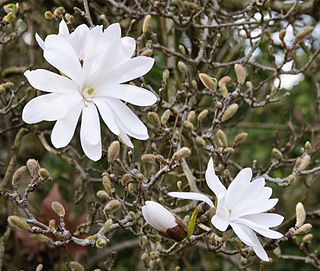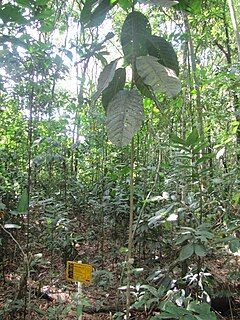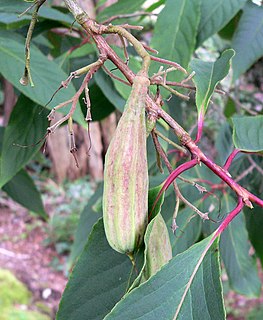
The magnolia warbler is a member of the wood warbler family Parulidae.

Magnolia acuminata, commonly called the cucumber tree, cucumber magnolia or blue magnolia, is one of the largest magnolias, and one of the cold-hardiest. It is a large forest tree of the Eastern United States and Southern Ontario in Canada. It is a tree that tends to occur singly as scattered specimens, rather than in groves.

Magnolia virginiana, most commonly known as sweetbay magnolia, or merely sweetbay, is a member of the magnolia family, Magnoliaceae. It was the first magnolia to be scientifically described under modern rules of botanical nomenclature, and is the type species of the genus Magnolia; as Magnolia is also the type genus of all flowering plants (magnoliophytes), this species in a sense typifies all flowering plants.

Magnolia stellata, sometimes called the star magnolia, is a slow-growing shrub or small tree native to Japan. It bears large, showy white or pink flowers in early spring, before its leaves open. This species is closely related to the Kobushi magnolia, and is treated by many botanists as a variety or even a cultivar of that. However, Magnolia stellata was accepted as a distinct species in the 1998 monograph by Hunt.

Magnolia tripetala, commonly called umbrella magnolia or simply umbrella-tree, is a deciduous tree native to the eastern United States in the Appalachian Mountains, the Ozarks, and the Ouachita Mountains. The name "umbrella tree" derives from the fact that the large leaves are clustered at the tips of the branches forming an umbrella-shaped structure.

Magnolia fraseri, commonly known as Fraser magnolia, mountain magnolia, earleaf cucumbertree, or mountain-oread, is a species of magnolia native to the south-eastern United States in the southern Appalachian Mountains and adjacent Atlantic and Gulf Coastal Plain from West Virginia south to northern Florida and west to eastern Texas. The Appalachian plants are classified as Magnolia fraseri var. fraseri, and the more coastal plants as M. fraseri var. pyramidata. These two kinds of magnolia are often recognized as distinct species, M. fraseri and M. pyramidata, respectively.

Magnolia macrophylla, the bigleaf magnolia, is a deciduous magnolia native to the southeastern United States and eastern Mexico. This species boasts the largest simple leaf and single flower of any native plant in North America.

Magnolia sieboldii, or Siebold's magnolia, also known as Korean mountain magnolia and Oyama magnolia, is a species of Magnolia native to east Asia in China, Japan, and Korea. It is named after the German doctor Philipp Franz von Siebold (1796–1866).

Magnolia delavayi is a species of flowering plant in the genus Magnolia. It is known by the common names of Chinese evergreen magnolia or Delavay's magnolia. It was named after Father Delavay, French Catholic missionary in China, who collected it.

Olea capensis, the black ironwood, is an African tree species in the olive family Oleaceae. It is widespread in sub-Saharan Africa: from the east in Somalia, Ethiopia and Sudan, south to the tip of South Africa, and west to Cameroon, Sierra Leone and the islands of the Gulf of Guinea, as well as Madagascar and the Comoros. It occurs in bush, littoral scrub and evergreen forest.

Athertonia is a genus of tall trees, constituting part of the plant family Proteaceae. It is a monotypic taxon, and the sole described species is Athertonia diversifolia, commonly known as Atherton oak. It is a small to medium-sized tree and is endemic to restricted tablelands and mountainous regions of the wet tropics rain forests of north-eastern Queensland, Australia, where it is widespread. For example, it grows in the Atherton Tableland region with which it shares its name, from the colonial pastoralist John Atherton (1837–1913). Its closest relatives are Heliciopsis and Virotia. A relative of the macadamia, it has potential as an ornamental tree and has an edible nut.

Magnolia hodgsonii, known in Chinese as gai lie mu is a species of Magnolia native to the forests of the Himalaya and southeastern Asia, occurring in Bhutan, southwestern China, Tibet, northeastern India, northern Myanmar, Nepal, and Thailand. It grows at moderate altitudes of 850–1500 m with a subtropical climate.

Magnolia kobus, known as mokryeon, kobus magnolia, or kobushi magnolia, is a species of Magnolia native to Japan and Korea and occasionally cultivated in temperate areas. It is a deciduous, small to tall tree which has a slow rate of growth but can reach 8–15 m (25–50 ft) in height and up to 10 m (35 ft) in spread.
Magnolia boliviana is a tree in the family Magnoliaceae native to the rainforests of the eastern Andean foothills of Bolivia.

Magnolia hernandezii is a species of plant in the family Magnoliaceae. It is endemic to Colombia. The tree can attain an height of up to 40 m and trunk diameter approaching 1 m with smooth, light-brown or light-grey bark. It has a woody, globular fruit with up to 15 cm diameter.

Rehderodendron macrocarpum is a species of flowering plant in the family Styracaceae, native to southwestern China and northern Vietnam, where it grows at altitudes of 1,000–1,500 m. It is threatened by habitat loss.
Staudtia pterocarpa, commonly known as pau-vermelho, is a species of plant in the family Myristicaceae. It is a tree that is endemic to São Tomé Island, sometimes growing to a height of 50 m (200 ft) with a trunk diameter of 10 cm (4 in) at chest height. It has characteristic reddish brown, flaky bark which has been used to treat medical conditions such as bruising. The timber is valuable in construction but the species is threatened by logging. The specific epithet (pterocarpa) is derived from the Ancient Greek words pteron meaning a “wing” or "feather" and karpos meaning "fruit".

Vateria indica, the white dammar, is a species of tree in the family Dipterocarpaceae. It is endemic to the Western Ghats mountains in India. It is threatened by habitat loss. It is a large canopy or emergent tree frequent in tropical wet evergreen forests of the low and mid-elevations.

Stenocarpus cryptocarpus, commonly known as the giant-leaved stenocarpus, is a species of flowering plant in the family Proteaceae and is endemic to north Queensland. It is a tree with buttress roots at the base, simple, mostly elliptical adult leaves, groups of cream-coloured flowers and narrow oblong follicles.
Magnolia sulawesiana is a large evergreen tree of the family Magnoliaceae that grows in tropical montane forests on the Indonesian island of Sulawesi.


















